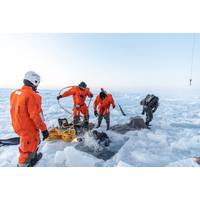
The Value of Friends in “High-Latitude” Places
designed to measure mean ocean temperature over great distances and long time periods to contribute to global warming research.On Nov. 25, after more than a month at sea, the Svalbard returned to port in Longyearbyen in Norway after the successful recovery of three American deep-water moorings in the Beaufort Sea. Executed on short notice, in challenging conditions, the successful recovery is a tribute to the collaborative spirit, bravery and expertise of the Norwegian navigators and scientists. It is also a great example of how U.S. allies, such as Norway, act as force multipliers and important team mates
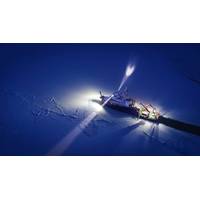
TECH FILE: Acoustic Tech Used to Understand Climate Change in the Arctic
December,” says Professor Jim Thomson, Senior Principal Oceanographer at the University of Washington’s Applied Physics Lab and a Professor in the Department of Civil & Environmental Engineering.Jim Thomson readies a fixed mooring equipped with a Signature500 ADCP for deployment in the Beaufort Sea. The instruments were left in situ for a year. Photo ©: Onpoint Outreach.Research necessary as melting ice exposes coastlines to harsh waves and erosionThe implications of the Arctic’s changing sea ice are many. On a global scale, sea ice influences global climate. Within the region

New Study Finds Polyester Fibers Throughout the Arctic Ocean
was led by a a team at Ocean Wise Conservation Association in Vancouver, and supported by field teams from Fisheries and Oceans Canada. We collected seawater samples from just below the surface of the Arctic Ocean as part of four scientific expeditions stretching from Tromsø, Norway, to the Beaufort Sea in North America.A total of 71 near-surface samples were collected across the Arctic. We also collected 26 samples from the Beaufort Sea from just below the surface down to a depth of 1,015 meters. We then filtered and analyzed the samples back at the Ocean Wise Plastics Lab using microscopes

ASL Hires Dr. Asplin
.Dr. Asplin had previously completed a NSERC Industrial Postdoctoral Research and Development Fellowship with ASL Environmental Sciences Inc. from 2013–2016. This research program was designed to continue the theme of study of his Ph.D. program as part of the ArcticNet–Industry Beaufort Sea Research collaboration between ArcticNet, BP, Imperial Oil, and ASL. He completed research within the following topics: 1) surface atmospheric circulation systems—changes and trends for the western Arctic, 2) momentum coupling of atmospheric forcing to ice and near-surface ocean
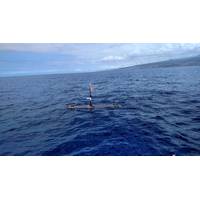
Wave Gliders to Study Arctic and Southern Oceans
through the world’s largest ocean current, the Antarctic Circumpolar Current,” said Dr. Jim Thomson, Senior Principal Oceanographer at The APL-UW. “The data collected provided unprecedented temporal and spatial coverage and I have great confidence our upcoming Arctic mission in the Beaufort Sea, part of the Stratified Ocean Dynamics of the Arctic, will again provide valuable insights.&rdquo
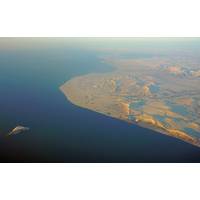
Alaska Requests Limits on US Offshore Drilling
but cut the 11 proposed sales in the Bering Sea and Gulf of Alaska. "Such a program will maximize agency resources and reflect the areas with the broadest support for development among Alaskans," Senators Lisa Murkowski, Dan Sullivan and Don Young said in the letter. The Beaufort Sea off Alaska's northern coast is the federal offshore Alaska area with the most exploration drilling to date, but there is no producing oil field located entirely in federal Beaufort waters. The more remote Chukchi Sea, off northwestern Alaska and believed to hold vast amounts of oil and

Eni Begins Drilling Oil Well in Alaska's Beaufort Sea
Italian oil producer Eni this week began drilling a new well in U.S. waters off the north coast of Alaska, becoming the first company to do so since 2015, federal regulators said on Wednesday. The oil and gas firm is working from an artificial island in the Beaufort Sea about three miles off Oliktok Point in the Arctic Ocean. The well is expected to run more than 6 miles (10 km) long. The project could result in 20,000 barrels a day of oil production, according to regulator U.S. Bureau of Safety and Environmental Enforcement (BSEE), which said it sent employees to the site to ensure
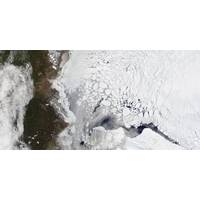
Trump Administration Approves Eni Plan to Drill Offshore Alaska
oil and gas drilling and make the country "energy dominant." The approval is conditional on Eni getting other state and federal permits, which in past cases are generally granted once BOEM gives the green light. "We know there are vast oil and gas resources under the Beaufort Sea, and we look forward to working with Eni in their efforts to tap into this energy potential," said BOEM's acting Director Walter Cruickshank. Eni plans to drill into the Beaufort Sea from an artificial island using extended wells more than 6 miles (10 km) long starting in December
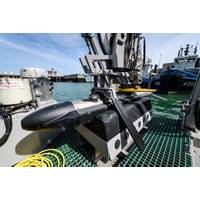
Klein's Mine Hunting Capabilities on Display
team to prove the seaworthiness of Seagull and the fact that the Klein 5900 is specifically designed to achieve SAS-like (or better) performance at survey speed in excess of 10 knots, even in problematic sea conditions, Klein said. During these trials, the Klein 5900 performed exceptionally well in Beaufort sea states of up to Sea State 5 with wind gusts of 30 knots delivering superb mine classification and identification grade imagery, the manufacturer said. Giuseppe Di Stefano, Klein Director of Marketing said, "Thanks to its survey speed of 10-12 knots, the Klein 5900 was able



 February 2024
February 2024





